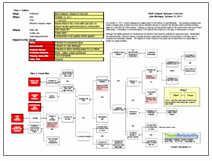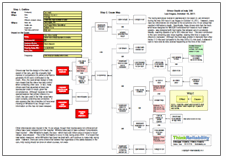In the history of nuclear weapons in the U.S., two accidents (or inadvertent drops) of nuclear weapons have resulted in widespread dispersal of nuclear materials. These two incidents occurred two years apart, within a week. The incidents had many similarities: in both cases, a B-52 bomber carrying nuclear weapons was damaged in air during an airborne alert mission and released nuclear weapons, which released radioactive material over a large area. In both cases, there were significant impacts to the safety, environmental, customer service, property and labor goals.
Palomares: On January 17, 1966, a B-52 and KC-135 crashed during refueling above Palomares, Spain. The KC 135 exploded, killing the entire crew of four. The B-52 broke up mid-air, killing three crew members (four more were able to eject) and releasing four nuclear weapons. Two of the weapons’ parachutes failed, and the weapons were destroyed, releasing radioactive material causing extensive cleanup of the 1,400 contaminated tons of soil and debris. (Additionally, one of the intact bombs fell into the ocean and was not recovered for three months.) This was the third refuel of the mission and it’s unclear what exactly went wrong, though due to the close proximity required, mid-air refueling is extremely risky.
Thule: A fire began in a B-52 when flammable cushions were stuffed under a seat, covering the heat duct. Hot air from the engine manifold was redirected into the cabin in an attempt to warm it up, which ignited the cushions. The crew of the B-52 was unable to extinguish the fire and the pilot lost instrument visibility. The generators failed (for reasons that aren’t clear), cutting all engine power. The crew bailed, the plane crashed, and the two weapons were destroyed along with the plane, again releasing radioactive material that led to a four-month cleanup mission.
 The causes of these two incidents have one thing in common – both resulted from planes carrying nuclear weapons as part of an airborne alert mission. Although many safeguards were taken due to the high risk of the missions, extremely serious impacts still resulted. Thus the decision was made to cancel airborne alert missions. When the risk is too high, sometimes the only solution is to end the situation resulting in the risk.
The causes of these two incidents have one thing in common – both resulted from planes carrying nuclear weapons as part of an airborne alert mission. Although many safeguards were taken due to the high risk of the missions, extremely serious impacts still resulted. Thus the decision was made to cancel airborne alert missions. When the risk is too high, sometimes the only solution is to end the situation resulting in the risk.
We can look at these two incidents together in a Cause Map, or visual root cause analysis. To view the Outlines, Timeline and Cause Maps in a three-page downloadable PDF, please click “Download PDF” above. Or click here to read more.









